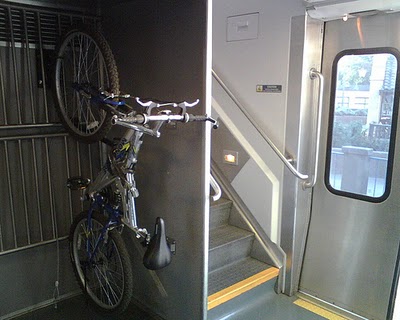For those that missed it in Today's Headlines or the follow-up on Curbed, we bring some good news. Amtrak California modified its plans to require a $5 fee for bicycles to ride on the Pacific Surfliner trains, a fee that would have basically ended bike to train commuting for the handful of people who choose that particular commute. However, the agency is still requiring a reservation to insure that there is sufficient space on their trains.

They are proceeding with the new policy of requiring a reservation before any bicycles can be brought on board a Surfliner rail car, either on weekends or during a commute. To make a reservation, visit a ticket window or call 1-800-USA-Rail and attempt to navigate their system. I've been assured one can make multiple reservations at one time, again a nod to commuters, but I don't know anyone who has tried to do so.
And while the cancellation of the fee is good news, with all good news there is also some bad news with Amtrak. The Surfliner is now requiring that anyone with a Metrolink Monthly pass purchase an Amtrak ticket before being allowed to get a bike reservation. Amtrak and Metrolink have a deal where Metrolink monthly pass holders can ride on Surfliner trains at no cost provided that they are riding between stations covered by the monthly pass. Apparently, that deal doesn't apply to bicycles.
Amtrak spokespeople hope that the reservation system's inconveniences will be made up for by the piece of mind of knowing whether there will be space on the train for a bicycle. As people get familiar with the system, please be sure to let us know if this hope is fulfilled in the comments section. This of course assumes you are not a Metrolink monthly pass holder who will be asked to pay twice for a ride and make a special reservation.
On Amtrak and other rail forums, Streetsblog has been criticized for its incendiary headline when announcing the initial change in Surfliner policy from a pro-bicycle "bring your bikes on board" to a cumbersome, and at that time expensive, reservation system. While we stand by the tone and reporting in that story, the forums provided some excellent background information that explain why Amtrak decided on this particular change.
Steve Grande, with Train Web, explains.
When ALL of the Amtrak Pacific Surfliners used the new Surfliner Train Sets, there were bicycle racks at the bottom level of every car. These were not in a position where they were taking up the room of any seats. One could just walk right on, hang their bike onto the rack, and go take a seat. These cars were designed to make bringing a bicycle along easy. Each car had this on the bottom level except for maybe the Cafe Car, so there were 3 or 4 cars on ever train that could each take 3 bicycles...
The problem came up when they expanded the Pacific Surfliner frequency and the length of trains faster than adding new equipment. They started bringing back the old single level equipment. Thus one never knows when waiting for a train if a train with double level Surfliner equipment is going to pull in or if an old trainset with single level equipment is going to pull in. If it is the double level equipment, there is no problem. A person just rolls his bicycle onboard and hangs it up.
But if the single level pulls in, that is a whole other story! Those are not built to carry bicycles at all. In the old days they would require you to box up your bicycle and take it on board as checked baggage.
But running the old single level equipment mixed with the new double level equipment has a lot more problems than just carrying bicycles.
The double level equipment loads tremendously faster than the single level equipment. Every car has two double doors on the double level equipment which means that it can load and unload passengers very fast. The single level equipment requires a Conductor at every door, thus limits the number of doors that can open. Passengers have to locate and scurry to the nearest open door, and then board single file up a set of stairs. The unloading and loading of single level equipment is much slower.
Since schedules have to be designed to accommodate the slowest equipment on the line, having the single level equipment mixed into the schedule totally defeats the advantage of the fast loading double level equipment.
A tip of the hat to Dana Gabbard and Ken Ruben for all their help in researching this story.






